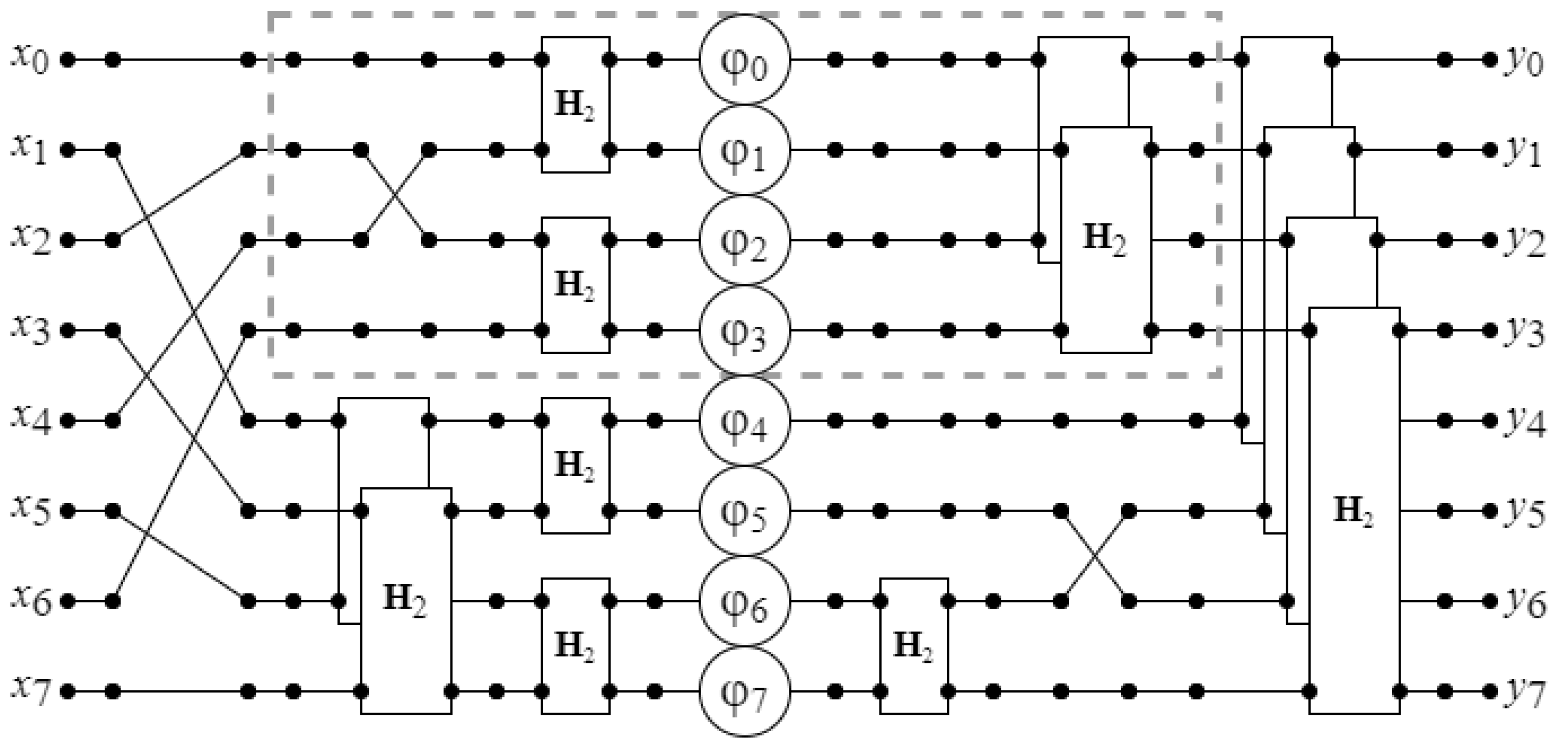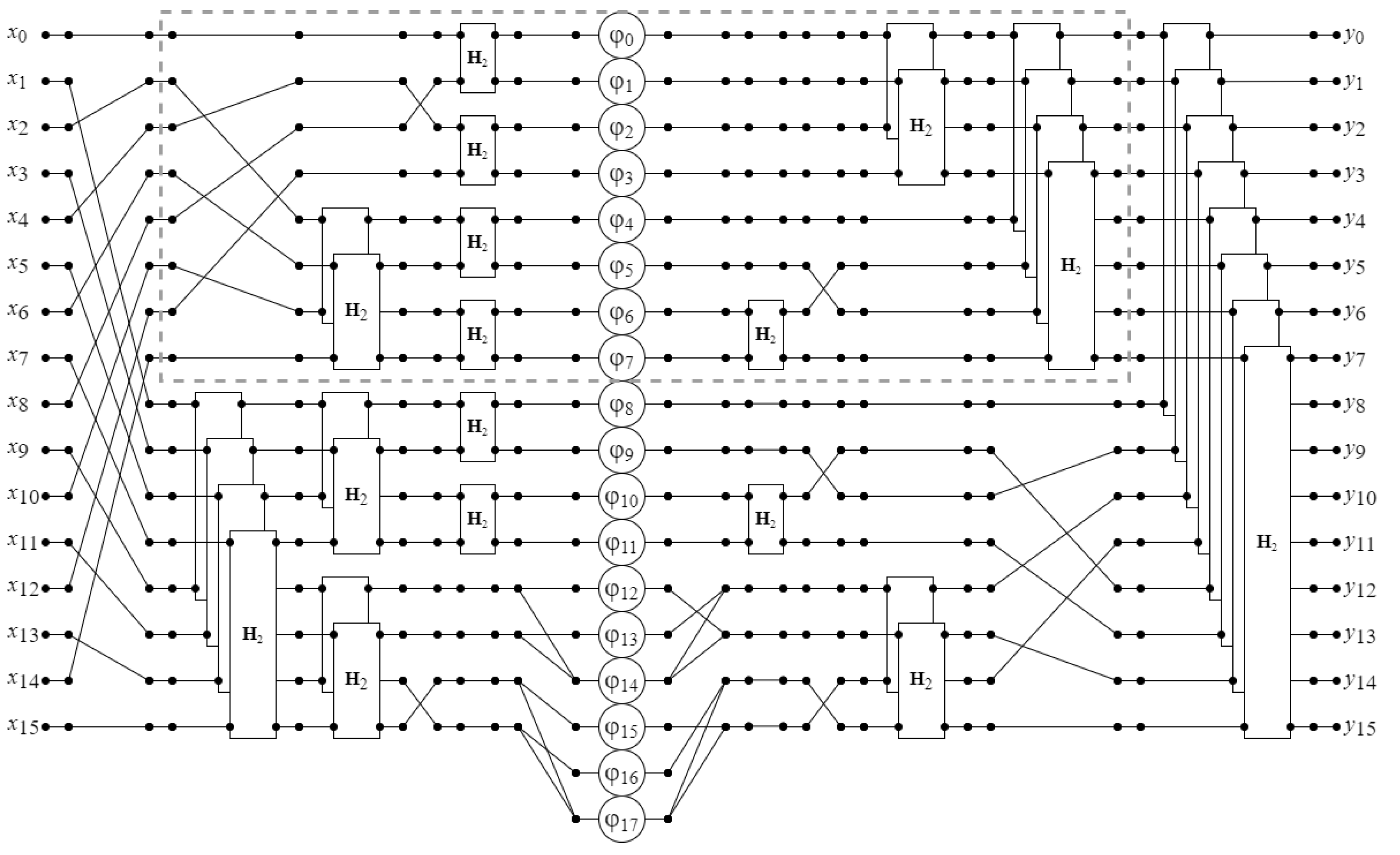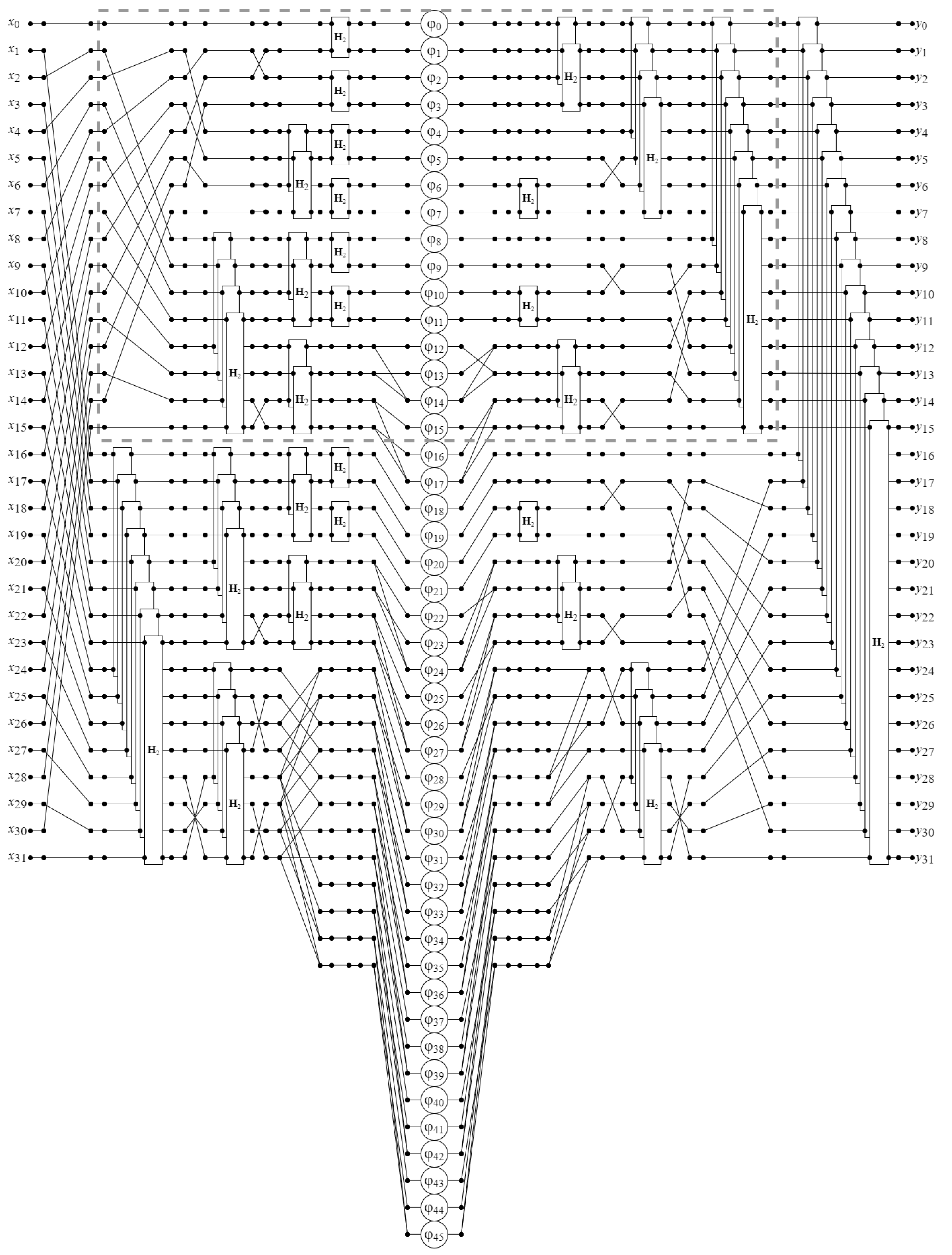On the Derivation of Winograd-Type DFT Algorithms for Input Sequences Whose Length Is a Power of Two
Abstract
:1. Introduction
2. Preliminary Remarks
3. Short Background
4. Synthesis of the Fast Winograd-Type DFT Algorithms
4.1. Fast DFT Algorithm for N = 4
4.2. Fast DFT Algorithm for N = 8
4.3. Fast DFT Algorithm for N = 16
4.4. Fast DFT Algorithm for N = 32
5. Conclusions
Author Contributions
Funding
Institutional Review Board Statement
Informed Consent Statement
Data Availability Statement
Acknowledgments
Conflicts of Interest
References
- McClellan, J.H.; Rader, C.M. Number Theory in Digital Signal Processing; Prentice-Hall Signal Processing Series; Prentice-Hall: Englewood Cliffs, NJ, USA, 1979. [Google Scholar]
- Douglas, E.; Rao, K.R. Fast Transforms Algorithms, Analyses, Applications; Academic Press: Cambridge, MA, USA, 1982. [Google Scholar]
- Elliott, D.F. (Ed.) Handbook of Digital Signal Processing: Engineering Applications; Academic Press: San Diego, CA, USA, 1987. [Google Scholar]
- Nussbaumer, H.J. Fast Fourier Transform and Convolution Algorithms; Springer Series in Information Sciences; Springer: Berlin/Heidelberg, Germany, 1982; Volume 2. [Google Scholar] [CrossRef]
- Burrus, C.S.; Parks, T.W.; Potts, J.F. DFT/FFT and Convolution Algorithms: Theory and Implementation; Topics in Digital Signal Processing; Wiley: New York, NY, USA, 1984. [Google Scholar]
- Blahut, R.E. Fast Algorithms for Digital Signal Processing; Addison-Wesley Pub. Co.: Reading, MA, USA, 1985. [Google Scholar]
- Tolimieri, R.; An, M.; Lu, C. Algorithms for Discrete Fourier Transform and Convolution; Signal Processing and Digital Filtering; Springer: New York, NY, USA, 1989. [Google Scholar] [CrossRef]
- Smith, W.W.; Smith, J.M. Handbook of Real-Time Fast Fourier Transforms: Algorithms to Product Testing; IEEE Press: New York, NY, USA, 1995. [Google Scholar]
- Parhi, K.K. VLSI Digital Signal Processing Systems: Design and implementation; Wiley: New York, NY, USA, 1999. [Google Scholar]
- Moon, T.K.; Stirling, W.C. Mathematical Methods and Algorithms for Signal Processing; Prentice Hall: Upper Saddle River, NJ, USA, 2000. [Google Scholar]
- Garg, H.K. Digital Signal Processing Algorithms: Number Theory, Convolution, Fast Fourier Transforms, and Applications; Press Computer Engineering Series; CRC Press: Boca Raton, FL, USA, 1998. [Google Scholar]
- Bi, G.; Zeng, Y. Transforms and Fast Algorithms for Signal Analysis and Representations; Birkhäuser Boston: Boston, MA, USA, 2004. [Google Scholar] [CrossRef]
- Burrus, C.S.; Selesnick, I. Winograd’s Short DFT Algorithms; OpenStax CNX, Rice University: Houston, TX, USA; Available online: http://cnx.org/content/m16333/latest (accessed on 15 March 2022).
- Winograd, S. On computing the discrete Fourier transform. Math. Comput. 1978, 32, 175–199. [Google Scholar] [CrossRef]
- Silverman, H. An introduction to programming the Winograd Fourier transform algorithm (WFTA). IEEE Trans. Acoust. Speech Signal Process. 1977, 25, 152–165. [Google Scholar] [CrossRef]
- Regalia, P.A.; Sanjit, M.K. Kronecker Products, Unitary Matrices and Signal Processing Applications. SIAM Rev. 1989, 31, 586–613. [Google Scholar] [CrossRef]
- Steeb, W.H.; Hardy, Y. Matrix Calculus and Kronecker Product: A Practical Approach to Linear and Multilinear Algebra, 2nd ed.; World Scientific: Singapore, 2011. [Google Scholar] [CrossRef]
- Beck, A.; Tetruashvili, L. On the Convergence of Block Coordinate Descent Type Methods. SIAM J. Optim. 2013, 23, 2037–2060. [Google Scholar] [CrossRef]
- Cariow, A. Strategies for the Synthesis of Fast Algorithms for the Computation of the Matrix-vector Products. J. Signal Process. Theory Appl. 2014. [Google Scholar] [CrossRef]
- Andreatto, B.; Cariow, A. Automatic generation of fast algorithms for matrix–vector multiplication. Int. J. Comput. Math. 2018, 95, 626–644. [Google Scholar] [CrossRef]




Publisher’s Note: MDPI stays neutral with regard to jurisdictional claims in published maps and institutional affiliations. |
© 2022 by the authors. Licensee MDPI, Basel, Switzerland. This article is an open access article distributed under the terms and conditions of the Creative Commons Attribution (CC BY) license (https://creativecommons.org/licenses/by/4.0/).
Share and Cite
Raciborski, M.; Cariow, A. On the Derivation of Winograd-Type DFT Algorithms for Input Sequences Whose Length Is a Power of Two. Electronics 2022, 11, 1342. https://doi.org/10.3390/electronics11091342
Raciborski M, Cariow A. On the Derivation of Winograd-Type DFT Algorithms for Input Sequences Whose Length Is a Power of Two. Electronics. 2022; 11(9):1342. https://doi.org/10.3390/electronics11091342
Chicago/Turabian StyleRaciborski, Mateusz, and Aleksandr Cariow. 2022. "On the Derivation of Winograd-Type DFT Algorithms for Input Sequences Whose Length Is a Power of Two" Electronics 11, no. 9: 1342. https://doi.org/10.3390/electronics11091342
APA StyleRaciborski, M., & Cariow, A. (2022). On the Derivation of Winograd-Type DFT Algorithms for Input Sequences Whose Length Is a Power of Two. Electronics, 11(9), 1342. https://doi.org/10.3390/electronics11091342






